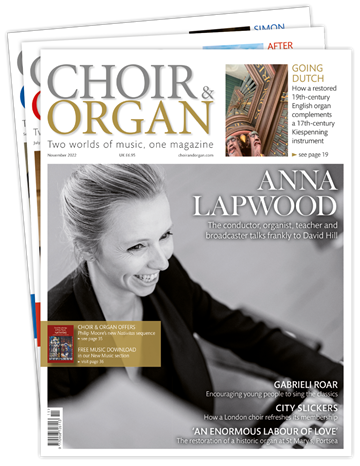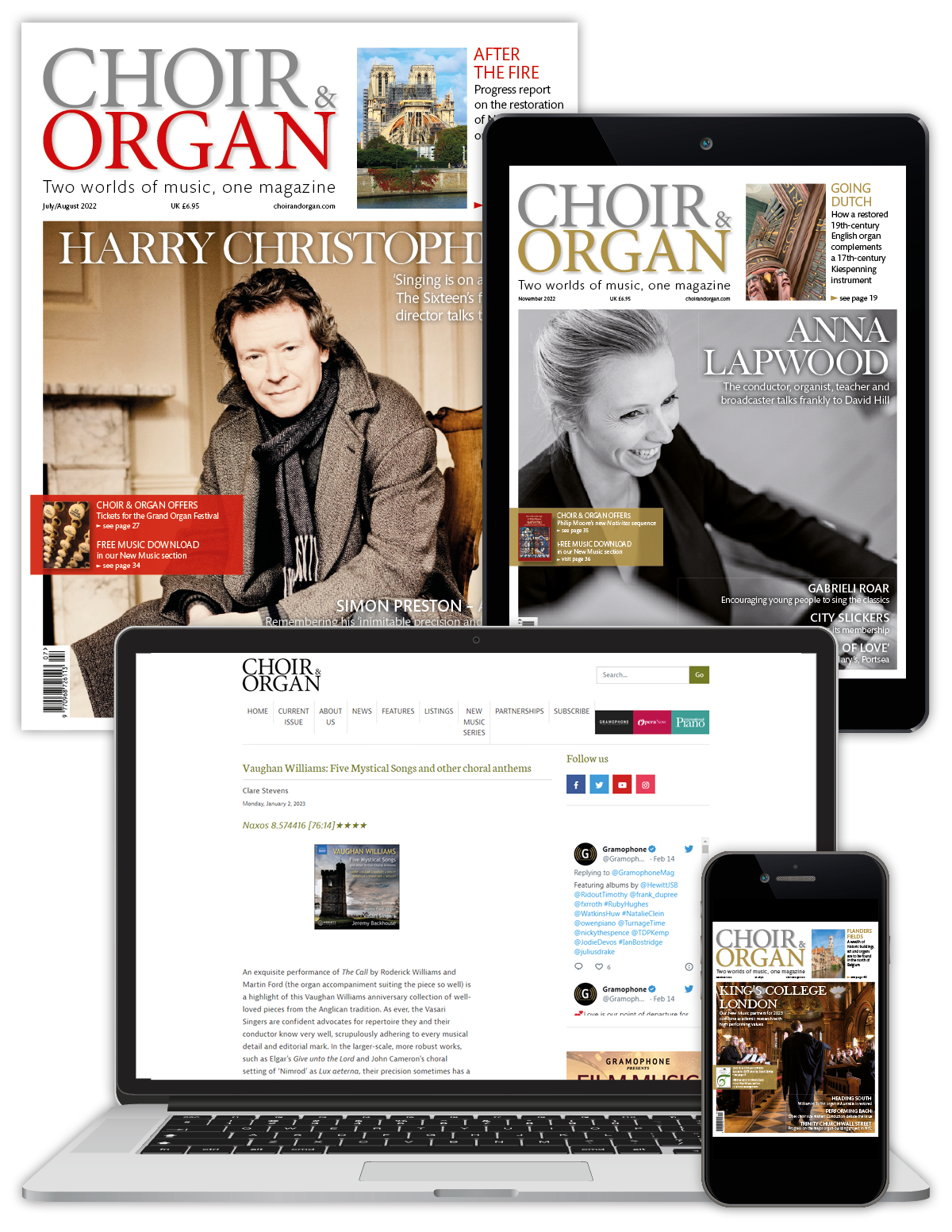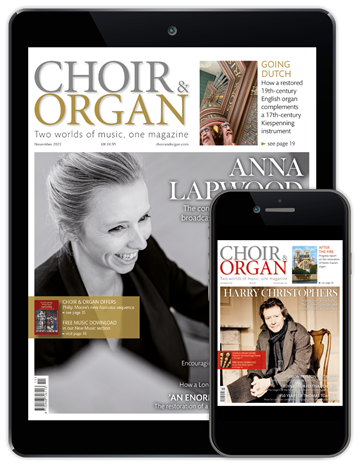Norwich Cathedral organ: restored to its full magnificence
Stephen Farr
Friday, February 23, 2024
The much anticipated rebuild, by Harrison & Harrison, at Norwich Cathedral merges new pipework into a restored tonal palette with brilliance. Stephen Farr assesses the results

Over the course of the 20th century, the organ of Norwich Cathedral underwent an eye-opening – and for contemporary listeners, probably ear-opening – transformation. From the relatively modest Norman and Beard instrument in position at the turn of the century (around 60 speaking stops, including an Echo division) it had become, after the Hill, Norman and Beard (HNB) rebuild of 1938-42, an instrument of more than 100 stops (the Echo of the 1899 instrument now disconnected). Around half of the pipework of this organ was new. By 1970, after further work by HNB, the instrument was essentially two organs, facing in two directions, and arguably attempting to marry two mutually exclusive approaches to tonal design. Facing east was a small two-manual organ for choral accompaniment purposes, with an enclosed Choir-Swell division and a Baroque-style Positif. Facing west were the Swell and Solo (this latter division further demarcated acoustically by an internal wall inside the case, barring egress of sound towards the choir stalls), two Great divisions (one on the screen and one in the north triforium, the screen Great voiced with a strong tendency towards the neo-Classical and the Primary Great in the triforium leaning more towards the traditional). The whole was completed by a large Pedal division which made generous use of borrowing and extension.
In this incarnation, the instrument presented notable challenges of internal balance and overall cohesion, despite its many rewarding aspects; it was in many ways a rather baffling organ. Post-1970, the voicing of the newer chorus work (and in places the revoicing of existing stops) sat uneasily with the still substantial amounts of earlier HNB material, and the placing of divisions within the screen case (the notably elegant creation of Stephen Dykes Bower, 1950) resulted in severely limited options for choral accompaniment, which of course remained the main function of the organ. The west-facing divisions of the instrument were of limited usefulness in the eastern half of the building; the east-facing divisions offered too limited a palette of timbre and dynamic range; and the Pedal could overwhelm unless used with extraordinary discretion.

Voicer Andrew Fiddes with the Solo Contra Viole
By the end of the 20th century, as the instrument began to show inevitable signs of age, it became increasingly clear that these issues needed to be addressed if the instrument were to meet adequately the increasingly varied demands placed upon it. The cathedral musicians (Ashley Grote, master of music, and David Dunnett, organist) and consultant Dr Nicholas Thistlethwaite developed in consultation with Harrison & Harrison a creative but conservative scheme whose aim was to improve the blend and projection of the whole instrument, while preserving the distinctive HNB timbres which were an important part of its still impressive effect. The H&H team, collectively responsible with other colleagues for the resulting transformation of the organ, should be named at this point: Jim Reeves, team leader; Andrew Hale, head designer; Owen Woods, projects manager; Andrew Scott, pipe scaling; Andrew Fiddes and Daniel Rose-Jones, voicing; James Richardson-Jones, blower refurbishment, wiring and Cymbelstern; Robert Woodland and Debra Miller, gilding.
Judged by the evidence of an evening spent on the instrument at the very end of 2023 (with the integral iPod recording device to assist assessment of the organ’s effect in the building) the rebuild has been notably successful in achieving its aspirations. There have been (horribile dictu for some, perhaps) judicious and apposite tonal alterations – of which more later – but these have been conceived in tandem with another fundamental change: namely, the major realignment of the organ’s internal layout. The screen Great and Swell soundboards have been turned through 90 degrees; these departments now speak far more clearly in the east of the building and are at last brought into play as fully viable resources for accompaniment. The ‘roof’ over the screen Great has also been removed (its introduction was perhaps inspired by the tone cabinets of the 1960s, and design aspects of the Royal Festival Hall instrument). Ironically, this roof had the reverse of its intended effect of improving projection of sound; in reality, it prevented the division interacting optimally with the stone vault which runs like a spine along the building. This aspect of the instrument’s relationship to its acoustic environment is now greatly enhanced.
The flexibility of both Swell and Solo is much increased by the provision of two sets of shutters for each department (facing west/north and west/east respectively), whose operation can be selected independently by drawstop. This nuance of design creates an additional reflective surface within the case – the non-operative shutters close when the relevant stop is selected – and allows the sound of each to be directed most effectively, opening up possibilities for creative use of the divisions’ position within the case. This was demonstrated to fine effect in a recent BBC Singers concert, when Ashley Grote (accompanying the choir on the west side of the screen) used the east Swell shutters rather than the west. This allowed use of full range of the division’s dynamics without overwhelming the singers and produced a striking sense of additional space and ‘bloom’ around the sound.

View from the east: the revised tonal scheme and internal layout allows tonal egress into the cathedral’s stone vault like never before
Turning to matters of tonal design – inevitably more controversial – a substantial part of the builders’ work has been to repair and tidy existing pipework, with new pipework introduced only where existing resources were not viable for reuse. Only the Positif and Secondary Great have been (almost) entirely removed from the instrument. Division by division, the main changes are as follows:
Solo: the French Horn is new, replacing a famously capricious and much revoiced register. The Harmonic Flute 8 is likewise new, and there has been some revoicing and regulation of soft orchestral reeds.
Swell: the Mixture has been recast, and the rather over-assertive Sharp Mixture removed. The Horn and some 8ft fluework has been revoiced; the 16.8.4 chorus reeds, Sesquialtera and strings are new. The Vox Humana has been transferred from the Solo and revoiced for its new position.
Pedal: new 8 and 4ft principals and Twelfth, and Mixture partly new, and provided to match the new screen Great chorus; Swell Double Trumpet 16 now available by borrowing.
Grand (previously Primary Great): pipework revoiced, with Harmonic Clarabella 8 added (revoiced Solo Harmonic Flute 8). Cymbelstern revoiced.
Great (screen): completely new, with some repurposing of existing pipework (Stopped Diapason taken from old Secondary Great Gedeckt 16, revoiced; Geigen 16 is from old Swell Geigen 16 revoiced; Cornet V existing register, revoiced).
Choir: new, except for Lieblich Bourdon 16, Open Diapason 8, Viole d’Amour 8, Gemshorn 4 and Fifteenth 2 (these originate in existing Choir-Swell and Positif pipework, in part revoiced). Great Primary Quint repurposed in part for Rohr Flute 8.
The most far-reaching tonal change is self-evidently in the provision of new screen Great and Choir divisions. These introductions seem on the basis of (a) a brief but thorough test drive, and (b) in-recital experience with their previous equivalents, to be entirely successful. They offer, as a starting point, a wide range of blended and internally balanced chorus combinations, underpinned in archetypal plenum combinations by a Pedal division which allows a wide range of dynamic shading (two enclosed 16ft Pedal reeds do not seem a luxury in this context). The screen Great chorus now speaks clearly and supportively into the choir stalls, while the triforium Grand keeps its assertive – indeed, thrilling – character, but with revoiced reeds whose speech reflects rather less of the county’s proud agricultural heritage than was perhaps previously the case. The effect of this division is not confined to the nave: it adds perceptible weight and brilliance to the sound east of the screen as well and the tutti is magnificent in effect. The provision of a substantial flute, which does double duty as a solo stop of great lyricism to the east of the screen, is an inspired stroke.
The Choir division is an equally welcome newcomer. Mutations and reeds (the Trompette 8 is ideally scaled for the space) allow the mixing of much subtle colour (the Cornet offers a distinctly different timbral experience to the winsome new Swell Sesquialtera, but of equal finesse) and the division speaks into the surprisingly confined choir stalls with what seems to be a perfectly calibrated balance of intimacy and clarity, even when the full chorus is drawn. Harrisons’ approach to the marriage of older and newer material is at its most subtle here; the inclusion of the Viole from the previous organ adds characteristic colour to flue combinations, sitting so perfectly within the sonic character of the new pipework it seems they were always together.
It goes without saying that the console design is elegant and uncluttered. It’s both amusing and oddly salutary to have a reminder of the epic dimensions of its predecessor, whose outer wooden frame remains in position, and of which the location of the Swell Clarion drawstop somewhere near Birmingham (or so it used to seem) was such a characteristic feature. Mechanically too, the instrument satisfies; playing actions are crisp and clean, allowing enough rapidity of repetition to make the Duruflé Alain easily manageable, and electrically assisted swell boxes helpfully still offer the essential ergonomic feedback of mechanical systems.
Visually, the instrument is restored to full magnificence, with the regilding of the case pipes in the exquisite proportions of the case especially resplendent. Many regard the 1950 Norwich case as one of the finest of its type; the instrument now housed within it provides a suitable aural foil to that elegance of those proportions, and a musically well-reasoned symbiosis of newer and older approaches.
Stephen Farr is an internationally active recitalist, accompanist and continuo player, with a discography that extends from the 16th to the 21st century. He is director of music at All Saints Margaret Street in London, and chief examiner of the Royal College of Organists
This article originally appeared in the Spring 2024 issue of Choir & Organ magazine. Never miss an issue – subscribe today






